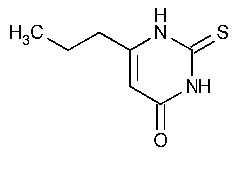Propylthiouracil
4(1H)-Pyrimidinone,2,3-dihydro-6-propyl-2-thioxo-.
6-Propyl-2-thiouracil [51-52-5].
»Propylthiouracil contains not less than 98.0percent and not more than 100.5percent of C7H10N2OS,calculated on the dried basis.
Packaging and storage—
Preserve in well-closed,light-resistant containers.
Identification,Infrared Absorption á197Kñ.
Loss on drying á731ñ—
Dry it at 105 for 2hours:it loses not more than 0.5%of its weight.
for 2hours:it loses not more than 0.5%of its weight.
Residue on ignition á281ñ:
not more than 0.1%.
Selenium á291ñ:
0.003%,a 200-mg specimen being used.
Heavy metals,Method IIá231ñ:
0.002%.
Ordinary impurities á466ñ—
Test solution:
methanol.
Standard solution:
methanol.
Application volume:
10µL.
Eluant:
a mixture of toluene,ethyl acetate,and formic acid (50:45:5),in a nonequilibrated chamber.
Visualization:
1.
Organic volatile impurities,Method Vá467ñ:
meets the requirements.
Solvent—
Use dimethyl sulfoxide.
Assay—
Weigh accurately about 300mg of Propylthiouracil,transfer to a 500-mLconical flask,and add 30mLof water.Add from a buret about 30mLof 0.1Nsodium hydroxide VS,heat to boiling,and agitate until solution is complete.Wash down any particles on the wall of the flask with a few mLof water,then add about 50mLof 0.1Nsilver nitrate while mixing,and boil gently for 7minutes.Cool to room temperature,and continue to titrate with 0.1Nsodium hydroxide VS,determining the endpoint potentiometrically,using a glass-calomel electrode system.Each mLof 0.1Nsodium hydroxide is equivalent to 8.512mg of C7H10N2OS.
Auxiliary Information—
Staff Liaison:Elena Gonikberg,Ph.D.,Scientist
Expert Committee:(PA4)Pharmaceutical Analysis 4
USP28–NF23Page 1666
Phone Number:1-301-816-8251
